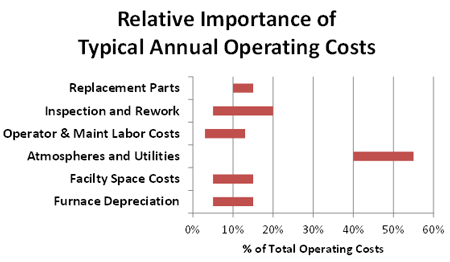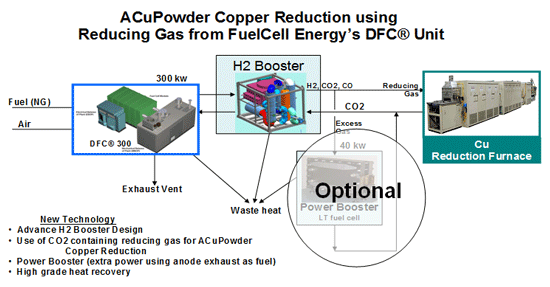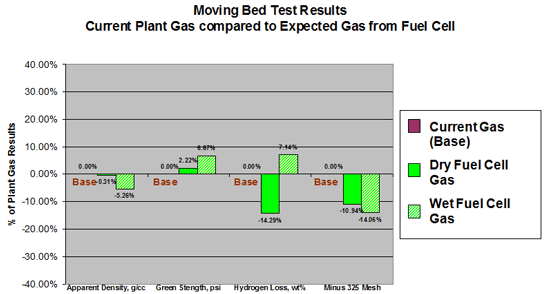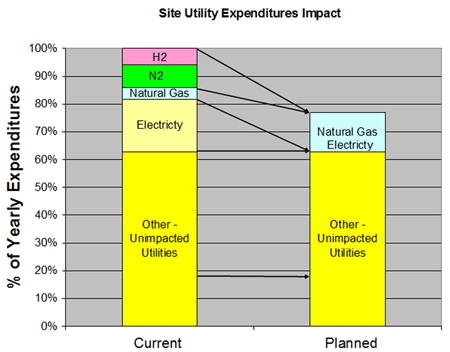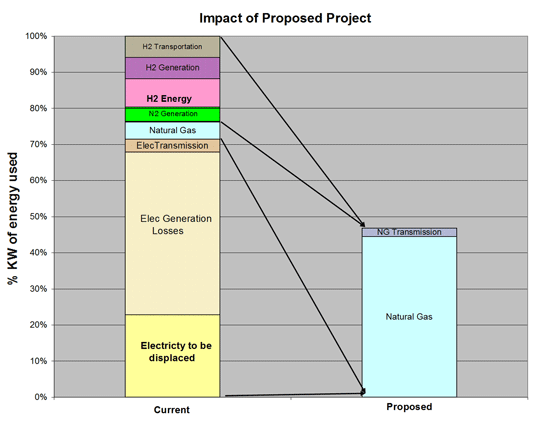Fuel cell system delivers benefits in copper powder annealing
Dr. David Whittaker reviews this presentation exclusively for ipmd.net
To enhance operating costs in copper powder production, FuelCell Energy (FCE) and ACuPowder (ACP) are now at an advanced stage of a joint project, aimed at installing an on-site reducing gas and power generation system at ACP’s powder manufacturing site.
Reducing gas and power consumption are typically the largest operating costs (around 50%) in metal powder annealing (Fig. 1). On-site production of both reducing gas and power can therefore enhance economics and efficiency of powder production systems significantly.
CHHP (combined heat, hydrogen and power) would have a particularly large impact (both economic and environmental) because it not only recovers energy, but also avoids the energy lost in compression, liquefaction and delivery of hydrogen.
High temperature fuel cells can consume only 70 to 80% of their fuel. The unconsumed fuel (containing hydrogen) is essentially a waste stream that is generally oxidised to generate heat. To maximise efficiency, it is better to recover this fuel as by-product hydrogen and /or reducing gas. The best by-product is dry reducing gas, a mixture of CO2 and H2, as this requires the lowest capital investment and provides the greatest efficiency boost. This is because no power for purification is needed and the CO2 in the gas can replace purchased liquid N2. The proposed project will replace both liquid H2 and liquid N2 currently supplied from off-site as shown in Fig. 2.
Bright annealing processes, used in the copper and iron powder production industries, often use a reducing gas similar in composition to the unconsumed anode exhaust gas from a carbonate fuel cell (MCFC), except that the hydrogen is diluted with carbon dioxide rather than nitrogen. ACP plans to use the reducing gas produced directly from a FCE 300 kW fuel cell to provide the gas needed in the company’s reduction furnaces.
As shown in Fig. 2, unused fuel from the anode exhaust in the form of hydrogen and carbon monoxide is directed from the high temperature fuel cell to a Hydrogen Booster. This system cools the exhaust and boosts the hydrogen content using the water gas shift reaction
CO + H2O → H2 + CO2
to maximise the hydrogen content and minimise the CO in the gas. Water is also condensed and removed from the gas. The dry mixture of H2 and CO2 is then used in the copper reduction furnace to reduce copper oxide powder to copper metal. Excess gas not required by the furnace can (optionally) be directed to a low temperature fuel cell to produce additional power (and increase efficiency) or can be used to produce heat for on-site use. Waste heat from the exhaust gas cooling and fuel cell cooling is captured and used for space heating.
Annealing furnaces use hydrogen and nitrogen to safely produce metal powders of desirable properties. The project team has examined the feasibility of replacing the nitrogen gas by carbon dioxide. Thermodynamic analysis has shown that for the operating conditions used in the ACP furnaces, CO2 can be treated as an inert gas. Thus, the reducing gas produced directly from the high temperature fuel cell may be substituted for both the hydrogen and the nitrogen currently consumed.
In order to validate this theoretical analysis, the project has gone through a number of stages. First, a simple test was conducted of reducing oxidised copper in the gas from an operating fuel cell unit. The copper was reduced and bright annealed by inserting an oxidised wire into the hot gas returning to the fuel cell. Thermodynamically, more noble metals, such as copper, can be reduced in the presence of CO2. Other metals may require pure hydrogen, in which case an electrochemical hydrogen separation (EHS) unit or other purification system would be included in the installation.
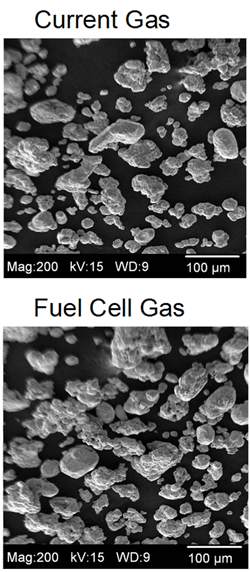
Fig. 4 Powders annealed in the current
reducing gas and in gas generated
by the fuel cell (Courtesy MPIF)
The next step was laboratory testing of actual copper powder reduction using simulated (bottled) reducing gas at ACP. The laboratory tests were performed in three different size furnaces, starting with a small fixed sample furnace and finishing with a large moving bed test furnace, using dry and wet low cost reducing gas compositions. Product powder was analysed using ACP’s normal characterisation methods. The laboratory tests (Fig. 3) showed that reduction of the copper using CO2/H2 instead of N2/H2 provided the same product quality. As shown in Fig. 3, the apparent density, green strength, hydrogen loss and particle size from the lower cost reducing gas were comparable with the base case using current plant gas. The scanning electron micrographs in Fig. 4 also showed no significant change in product appearance.
Next, simulated gas was tested on one of ACP’s commercial operating furnaces, with a typical batch size of 25,000 lbs. of copper powder. The material from this test proved to be within the normal acceptable range. Gas chromatographic measurements were made for hydrogen, carbon dioxide, nitrogen and humidity at different locations in the furnace. The experimental data are being analysed to develop operation and gas control strategies for the move to the low cost reducing gas.
The projected savings from producing reducing gas on site from a high temperature fuel cell are substantial. As shown in Fig. 5, for the ACP site, savings over 20% of the total site utility costs are estimated.
In terms of environmental benefits, Fig. 6 shows the projected reduction in energy use of ACP’s facilities before and after installation of the system (excluding energy use not impacted by system). As can be seen, although the system will increase the natural gas usage at the site, the amount of energy saved (on-site and off-site) will be more than double the energy required by the new system.
Based on the results of the various trials, the project team decided to proceed with the installation of the fuel cell and reducing gas system. A fuel cell unit has been procured, equipment to modify the standard fuel cell to co-produce reducing gas is under construction and permitting of the system is proceeding. Currently, installation on site is targeted for the last quarter of 2012.
News | Articles | Market reviews | Search directory | Subscribe to e-newsletter



